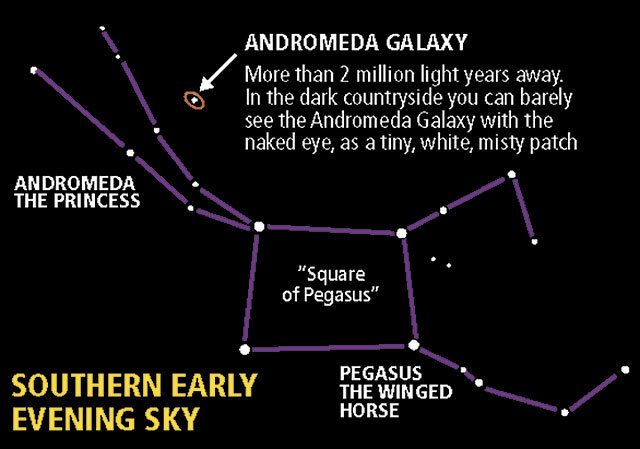How many of you know of the 1971 sci-fi thriller “The Andromeda Strain?” The plot of the movie — and the 1969 Michael Crichton novel of the same name — centered around an extraterrestrial organism accidentally brought back to Earth by a re-entering satellite. The organism gets loose and threatens to wipe out all life on our home planet.
Tonight in the high eastern sky, there’s an Andromeda strain waiting for you that’s completely harmless, and hopefully will delight you: the Andromeda Galaxy. It’s truly well out of this world, and is said by many to be the farthest thing you can see with the naked eye. You will have to really strain your eyes to see it, although in the countryside with a pitch-black sky on a moonless night it’s certainly possible. Look for a faint misty patch of light just above the constellation Andromeda. Binoculars or a small telescope will really bring it in.
The best way to find the Andromeda Galaxy is to locate the four moderately bright stars of the “Square of Pegasus” in the eastern sky, the main part of the constellation Pegasus the Winged Horse. The square outlines the torso of the celestial horse. Then look for two curved lines of stars that are attached to the Square of Pegasus from the left corner star of the diamond. Those lines make up the constellation Andromeda the Princess. The lower arc of stars is much brighter than the upper arc.
The best way to find the Andromeda Galaxy is to follow the lower arc of the constellation Andromeda to a moderately bright star called Mirach. Then look above Mirach for two much fainter stars. Just above the upper star there will be a very small, faint, patchy cloud. That’s it, the Andromeda Galaxy. Again, you may need binoculars or a small telescope to find it.
Galaxies are vast islands of billions of stars. They come in all shapes and sizes. Our home galaxy, the Milky Way, is thought to have at least 200 billion stars arranged in a giant spiral over 100,000 light-years in diameter. All of the stars we see in our sky are members of the Milky Way galaxy. In really dark skies you can see a faint band of milky white light that stretches roughly from the northeast to the southwest sky. That’s the main plane and the thickest part of our galaxy.
The Andromeda Galaxy is a larger spiral galaxy than the Milky Way, with well over 200 billion stars in a diameter of possibly over 200,000 light-years. In fact, Andromeda is the largest spiral galaxy within 50 million light-years. Just as it is with our Milky Way, all of the stars in the Andromeda Galaxy are orbiting around a super massive black hole at Andromeda’s center. This mother of all black holes is believed to weigh as much as a million times more than our sun and 300,000 times more than our Earth. It’s the glue that gravitationally holds Andromeda together. In our own galaxy our sun obediently orbits around the black hole in the Milky Way’s center every 225 million years.
When I gaze upon the stars in our own Milky Way Galaxy, and when I look through the telescope at other distant galaxies, I can’t help but think about other planets like our own going around other stars. We know they’re out there. Just in our part of the Milky Way alone, there are more than 70 stars that are known to have a planet or planets circling them. Where there are planets, could there be life? Intelligent life? Are they watching their own version of “American Idol” somewhere in the Andromeda Galaxy?
There are no final answers for now, but it’s been said that even if there’s only one star in a billion with a solar system capable of life somewhere within it, there would still be thousands and thousands of worlds hidden inside Andromeda.
Here’s one more thing to think about when you gaze upon Andromeda. With every second that passes we get 50 miles closer to the Andromeda Galaxy. The Milky Way and the Andromeda Galaxies are on a collision course. Mark 4 billion to 6 billion years from now on your calendar. That’s when the Milky Way and Andromeda will merge together. Because of the vast distances between stars, the two galaxies may just slip through each other. There is a chance, though, that the two star families could merge together permanently in a stellar marriage of galactic proportions!
Mike Lynch is an amateur astronomer and professional broadcast meteorologist for WCCO Radio in Minneapolis.
Talk to us
> Give us your news tips.
> Send us a letter to the editor.
> More Herald contact information.

























